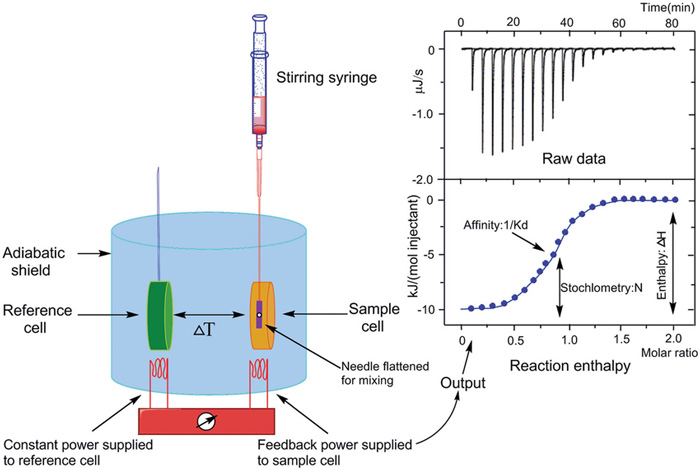ITC for Binding Assessment
Isothermal titration calorimetry (ITC) technology
Isothermal titration calorimetry is based on the measurement of the heat released or absorbed as the result of binding occurs, such as the binding event of a compound to its ligand. The binding affinity and heat change are allowed to be measured in a single experiment operation by performing a Isothermal titration calorimetry experiment and all binding-related parameters such as stoichiometry (N), affinity (Kd), enthalpy (△H) and entropy (△S) are simultaneously determined.

Fig.1 Basic principle of isothermal titration calorimetry. (Song, C.; et al. 2015)
Applications of ITC
Nowadays, Isothermal titration calorimetry technology has been widely used in the following areas of drug discovery and development:
- Quantify the molecular binding affinity.
- Screen and optimize the drug candidates.
- Determine the thermodynamic characteristics.
- Characterization of the mechanism of action mode.
- Conformation of the binding target of interested.
- Verification of the IC50 and EC50 values through the pilot screening.
- Assessment of the combined specificity.
- Determination of enzyme dynamics and mechanisms.
Our Services of ITC
Target identification
We help our customers to understand the bonding mechanism through the thermodynamic parameters obtained from Isothermal titration technique. Moreover, With our professional technology and state-of-the-art ITC facilities, we can determine the mechanism of action (MOA) of specific target pathways and develop physiologically relevant model systems for downstream screening analysis. Therefore, the drug depletion can be decreased and development timeline will be shorten significantly as well.
Hit identification
We have established a remarkable platform with our Isothermal titration calorimetry system, providing assessment for the quality of lead compound with the important information obtained from images of up to 75 samples per day. Since ITC method is typically used in a secondary screening in which the affinity between the compound and target enable to be compared. We use it to analyze multiple candidates and rank them based on the obtained thermodynamic parameters, helping to select the best candidate for lead optimization.
Lead optimization
Isothermal titration calorimetry techniques have been applied as a significant tool in the lead optimization. Our team in BOC Sciences utilize a large amount of data generated from ITC including hydrogen bond, van der Waals interactions (△H), hydrophobic interactions (△S) and stoichiometry (N) to measure the binding affinity. Furthermore, we provide guidance in the lead optimization to deliver the candidate drugs with the best potency and selectivity.
Fragment-Based Screening
Since ITC measures the heat generated by the molecular binding events without chemical modification or analytical design, we use physiologically relevant models directly to determine the protein-ligand structures. Our pharmaceutical and computational chemistry teams also provide expertise in screening fragment libraries with the application of Isothermal titration calorimetry. We help to measure the weak binding of hits and obtain a few compounds which have high-quality interactions with the target site.
Advantages of ITC
- We provide customized experiment operation in which the experimental conditions will be investigated and optimized, improving the efficiency in high throughput screening
- Our team offer more information gained from working additional experiments under different buffer or temperature states, assisting in researching special binding system for your project.
Equipment
BOC Sciences has established a GE Microcal auto-ITC200 for performing automated isothermal titration calorimetry which enable to measure small changes in heat capacity under constant temperature and pressure with high sensitivity, low volume and free of labeling.
Reference
- Song, C.; et al. Choosing a suitable method for the identification of replication origins in microbial genomes. Frontiers in Microbiology. 2015, 6: 1049.
※ It should be noted that our service is only used for research.

One-stop
Drug Discovery Services
- Experienced and qualified scientists functioning as project managers or study director
- Independent quality unit assuring regulatory compliance
- Methods validated per ICH GLP/GMP guidelines
- Rigorous sample tracking and handling procedures to prevent mistakes
- Controlled laboratory environment to prevent a whole new level of success
Online Inquiry

